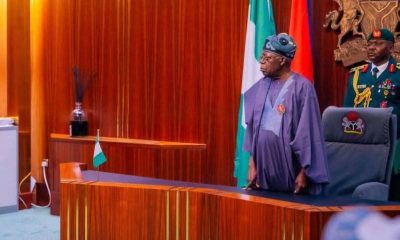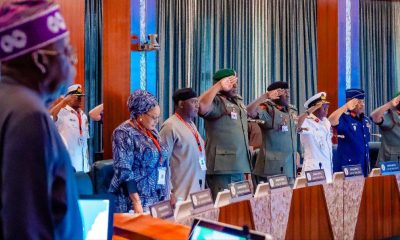Opinion
Nigerian education bank law and student loan: A preliminary review, By Tunde Adejumo

Whereas, it is no longer a news that, the much-clamored Education bank in the country is gradually coming to reality (following the enactment of the Student Loan (Access to Higher Education) law 2019, recently passed under the new administration of President Bola Ahmed Tinubu), it however appears there are some ambiguous areas and missing links on the new law causing some misconceptions about it amongst the concerned stakeholders in the country.
Thus, the need for some expositions on the new laws and its many desirable objectives.
To start with, the referenced law was strategically enacted to address the financial challenges associated with access to higher education in the country. This is necessary so as to improve the nation’s level of literacy and make higher education more accessible to Nigerian citizens.
This initiative (which had remained unsuccessful in the past) is seen as long-overdue and expected to yield the desired benefits this time. For avoidance of doubts, Student loan is not a new idea in Nigeria. It is on record that Nigerian governments at one time or the other (starting from the year 1972) had made several unsuccessful attempts to institutionalize Education loan in the country.
Those attempts were however, frustrated by the inherent challenges of poor implementation, management, and infidelity, leading to enormous level of default on the part of the beneficiaries. Till date, records of education loan defaulters under previous regimes exist in the country. Loan default unarguably is a serious concern among providers of credit facilities in Nigeria. This of course, speaks to the level of our fidelity as a people.
Generally, it could be argued that the maximum potential of credit facility is yet to be fully appreciated in Nigeria unlike it is in developed nations (such as Europe, Asia and America). In these informed climes, credit forms a critical pillar of their economic activities and daily lives. This consequently leads to better standard of living and rapid wealth creation. Perhaps it could also be argued that an average citizen in these countries (especially in America and UK) survives on credit in one way or the other.
Survival in these environments actually thrives on advances, starting from basic needs such as housing (through mortgage), home appliances (through equipment leasing), daily needs (through credit cards), to education (through student loans). Generally, credit galvanizes economies of advanced countries, by ensuring steady production and exchange, which result in sustainable job creation and security among other benefits.
Student loans play a major role in US higher education system. It is established that about 60% of US students’ population subscribes to annual borrowing to help cover costs.
Research also indicates that as at year 2021, approximately, 45million Americans held student debt, with an average balance of about $30,000 (i.e. =N=21million). A study attributed to the Organisation for Economic Cooperation and Development (OECD) revealed that over the last five years, student loans to GDP in America is in the average of 7%. Whereas, Global benchmark on national Debt-GDP ratio is put at 25%. This further substantiates the significance of student loans portfolio in the American economy.
The swift decision of President Bola Tinubu to give his assent to the referenced new law is in tandem with his administration’s intention and open declaration (in his inauguration speech of May 29 this year) to reinvigorate credit culture in the country. President Bola Tinubu holds the view that credit opportunity discourages corruption tendencies. This is in addition to its other multiplier impacts on economy in terms of sustainable production and exchange, job creation, and improved standard of living.
As a way of ameliorating the usual challenges being faced by students from poor families, students and most times their parents do approach friends, relatives and in some instances credit institutions (such as cooperative societies, and commercial banks) to solicit for loans to fund their children’s education in higher institutions. The bottlenecks in getting loans from these sources such as lack of collateral, and excessively high interest rate do make borrowings from conventional sources daunting.
Therefore, special loan such as envisaged under the new law will make higher education more accessible with little or no pain, to students from poor family especially. Therefore, loan under the new arrangement is to ensure among other things that students with high academic potentials but with financial constraints are not denied the opportunity of realizing their desired goals in life, and in turn contribute to national development.
In order to have a better understanding of the new law, it is considered important to note the following salient provisions therefrom the ungazetted version currently in circulation:
i. A bank to be known as Nigerian Education Bank (NEB) shall be established for implementation of the new Law. The bank, with an initial Share capital of =N=1billion shall be fully owned by the Federal government of Nigeria (FGN).
ii. Whereas, the NEB’s main objective shall be granting, and management of interest-free loans to students of higher learning specifically in government’s owned tertiary institutions, the bank is also expected to do other banking business across the country.
iii. Potential beneficiary of the loan is expected to be an existing student of any Government’s owned tertiary institutions in the country in good moral standing, with parents’ annual income below =N=500,000 (five hundred thousand Naira only), and such applicant must produce Personal guarantees from two people. The two guarantors must be any of the following: Civil servants of not less than 12 years in service; a Lawyer with not less than 10years post-call experience, a Judicial officer; or a Justice of Peace.
iv. The loan proceeds shall strictly be meant for payment of the beneficiary’s tuition only, and shall be disbursed directly to the beneficiary’s institution.
v. Funds for the planned students’ loans shall be sourced primarily from various revenues accruing to the Federation account from taxes, levies, duties and profits from oil and other minerals. The NEB shall be entitled to 1% of such national revenue.
vi. The NEB shall have a Board representing various stakeholders. As spelt out in the law, the Chairman of the board shall be a Professor and a retired Vice Chancellor of any Nigerian university. Other members of the board include: the bank’s MD, Secretary to the board, The minister of Education, the Chairman of National University Commission, a representatives of Vice Chancellor’s forum of all Nigeria universities, a representatives of the Rectors forum of all Nigerian Polytechnics and Colleges of Education in Nigeria, the Minister of Finance or his representative, the Auditor General of the Federation, a representative of the Nigerian Labour Congress, a representative of the Nigerian Bar Association, a representative of Academic staff union of universities.
vii. All applications for the students’ loan shall be through the applicant institution’s Students Affairs Office and Vice Chancellor or Rector or the head of the institution to the Chairman of the Bank’s Board.
viii. Processing of any applicant’s application, its approval by the Minister of Education, and its disbursement shall be made within 30days of the receipts of the application by the bank.
ix. Repayment of the loan by the beneficiary is to commence two years after completion of the mandatory National Youth Service Corps (NYSC) program. This shall be through direct deductions of 10% of the beneficiary’s salary at source by the employer and remitted to the Bank. Where the beneficiary is self-employed however, repayments shall be made by the beneficiary though remittance of 10% of his total monthly profit to his Student’s loan account with the Bank.
x. Anyone in default of the loan, or aiding its default shall be guilty of an offence and if convicted, shall be liable to imprisonment for two years or a fine of =N=500,000 or both.
Further review of the referenced law revealed the following areas requiring further deliberations so as to make the new law more robust and achieve the desired objectives with ease:
1. The membership of the NEB’s board: As approved, the board is expected to have 12 members (the Chairman, the bank’s MD, the Board Secretary, The minister of Education, the Chairman of National University Commission, a representatives of Vice Chancellor’s forum of all Nigeria universities, a representatives of the Rectors forum of all Nigerian Polytechnics and Colleges of Education in Nigeria, the Minister of Finance or his representative, the Auditor General of the Federation, a representative of the Nigerian Labour Congress, a representative of the Nigerian Bar Association, a representative of Academic staff union of universities). Usually, membership of any board or committee is expected to be an odd number. This is to avoid deadlock or vote tie on board decisions. There is therefore the need to increase the number of the members to 13 or reduce it to 11. In my view, the Director-General of the National Youth Services Corps (NYSC) or his representative might be included to make the board members 13.
2. Students‘ eligibility for the loan: Limiting eligibility of the prospective beneficiary students to only those whose parents’ annual income is not up to =N=500,000 seems too restrictive and may make the loan discriminatory and unpopular abinitio. An annual income of =N=500,000 translates to monthly earning of =N=41,095.89 per family. With the current minimum wage of =N=30,000 per month, the minimum bench mark should have been at least =N=720,000. In my view, to make the law achieve its desired objective, the maximum threshold of parents’ annual income may need to be increased from =N=500,000 to between =N=720,000 to =N=1million.
3. Focus of the loan: Whereas, the proposed loan as currently designed is meant to finance student’s tuition only, it should be remembered that tuition in public higher institutions (where such is currently applicable) constitutes just a portion of applicable fees of higher education in public institutions of higher learning in the country. It might therefore, be desirable to expand the scope of permissible expenses under the proposed loan arrangement to other related expenses such as Medical, Sport, Library fees, e.t.c. As it is currently spelt out under the law, a student whose tuition is funded under the new loan arrangement may still find it difficult to cope financially with other fees as enumerated.
4. Other terms of the loan: Whereas the 2 years grace period post NYSC program on the loan repayment looks plausible at least to give the loan beneficiary the opportunity of either securing a white-collar job, or embarking on an entrepreneurial endeavor before repayment of the loan, the tenor of the loan is however missing from the various provisions of the law. While it is anticipated that the board of the NEB shall fashion this out while coming up with its comprehensive implementation strategy for the law, a maximum tenor of between five (5) to ten (10) years might be appropriate, depending on the total loan granted each beneficiary.
The above identified areas of concern notwithstanding, emergence of this new law is certainly in line with the focus of the new government at the Federal level, and such is expected to change the narratives of accessibility to higher education in the country by all desirous individuals. It is also believed that further agitations from the concerned stakeholders on the new law particularly on matters relating to students’ loan shall be addressed over time once full implementation of the law begins.
Tunde Adejumo, PhD
Director-General, Osun Debt Management Office, Osogbo













